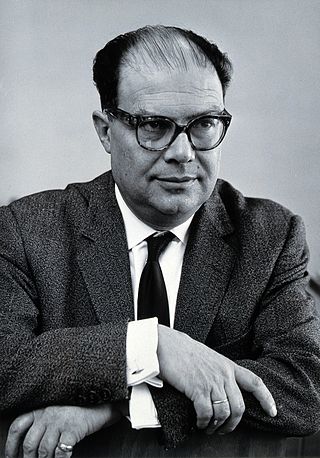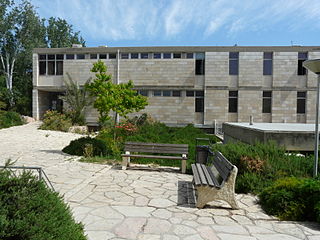
Giulio (Yoel) Racah(Hebrew: ג'וליו רקח; February 9, 1909 – August 28, 1965) was an Italian–Israeli physicist and mathematician. He was Acting President of the Hebrew University of Jerusalem from 1961 to 1962.
This article contains links to lists of scientists.

Daedalus is a prominent crater located near the center of the far side of the Moon. The inner wall is terraced, and there is a cluster of central peaks on the relatively flat floor. Because of its location, it has been proposed as the site of a future giant radio telescope, which would be scooped out of the crater itself, much like the Arecibo radio telescope, but on a vastly larger scale.

Anton Zeilinger is an Austrian quantum physicist and Nobel laureate in physics of 2022. Zeilinger is professor of physics emeritus at the University of Vienna and senior scientist at the Institute for Quantum Optics and Quantum Information of the Austrian Academy of Sciences. Most of his research concerns the fundamental aspects and applications of quantum entanglement.

De Vries is a lunar impact crater on the far side of the Moon relative to the Earth. It lies about midway between the craters Racah to the north-northwest and Orlov to the south-southeast. An nameless walled plain lies between De Vries and Orlov, with the perimeter of this feature joining the two rims.

Ugo Fano was an Italian American physicist, notable for contributions to theoretical physics.

Racah is a lunar impact crater on the far side of the moon. It lies almost due south of the larger crater Daedalus, and lies across lunar longitude 180°W, i.e. the longitude that is diametrically opposite to the Earth. To the west-southwest of Racah is the crater Aitken, and to the southeast lies De Vries.
In coordination chemistry, Tanabe–Sugano diagrams are used to predict absorptions in the ultraviolet (UV), visible and infrared (IR) electromagnetic spectrum of coordination compounds. The results from a Tanabe–Sugano diagram analysis of a metal complex can also be compared to experimental spectroscopic data. They are qualitatively useful and can be used to approximate the value of 10Dq, the ligand field splitting energy. Tanabe–Sugano diagrams can be used for both high spin and low spin complexes, unlike Orgel diagrams, which apply only to high spin complexes. Tanabe–Sugano diagrams can also be used to predict the size of the ligand field necessary to cause high-spin to low-spin transitions.
When an atom has more than one electron there will be some electrostatic repulsion between those electrons. The amount of repulsion varies from atom to atom, depending upon the number and spin of the electrons and the orbitals they occupy. The total repulsion can be expressed in terms of three parameters A, B and C which are known as the Racah parameters after Giulio Racah, who first described them. They are generally obtained empirically from gas-phase spectroscopic studies of atoms.

Racah's W-coefficients were introduced by Giulio Racah in 1942. These coefficients have a purely mathematical definition. In physics they are used in calculations involving the quantum mechanical description of angular momentum, for example in atomic theory.
In mathematics, Racah polynomials are orthogonal polynomials named after Giulio Racah, as their orthogonality relations are equivalent to his orthogonality relations for Racah coefficients.
In mathematics, the q-Racah polynomials are a family of basic hypergeometric orthogonal polynomials in the basic Askey scheme, introduced by Askey & Wilson (1979). Roelof Koekoek, Peter A. Lesky, and René F. Swarttouw (2010, 14) give a detailed list of their properties.
In mathematics, the Askey scheme is a way of organizing orthogonal polynomials of hypergeometric or basic hypergeometric type into a hierarchy. For the classical orthogonal polynomials discussed in Andrews & Askey (1985), the Askey scheme was first drawn by Labelle (1985) and by Askey and Wilson (1985), and has since been extended by Koekoek & Swarttouw (1998) and Koekoek, Lesky & Swarttouw (2010) to cover basic orthogonal polynomials.
In mathematics, a sequence of discrete orthogonal polynomials is a sequence of polynomials that are pairwise orthogonal with respect to a discrete measure. Examples include the discrete Chebyshev polynomials, Charlier polynomials, Krawtchouk polynomials, Meixner polynomials, dual Hahn polynomials, Hahn polynomials, and Racah polynomials.

The Racah Institute of Physics is an institute at the Hebrew University of Jerusalem, part of the faculty of Mathematics and Natural Sciences on the Edmund J. Safra Campus in the Givat Ram neighborhood of Jerusalem.
Lawrence Christian Biedenharn, Jr. was an American theoretical nuclear physicist and mathematical physicist, a leading expert on applications of Lie group theory to physics.
The Racah seniority number was introduced by Giulio Racah for the classification of electrons in an atomic configuration. The "seniority number", in a loosing statement, is quantum number additional to the total angular momentum and total spin , which gives the degree of unpaired particles.

Amri Wandel is a senior scientist in Astrophysics at the Racah Institute of Physics at the Hebrew University of Jerusalem. Wandel is an expert in astrobiology and chairman of the Israeli Association of Astrobiology and Early Life. He is also president of the International Academy of Sciences San Marino.
Eliezer Rabinovici is an Israeli theoretical physicist. He is emeritus Professor of Physics at The Racah Institute of Physics, Hebrew University of Jerusalem, working on theoretical high-energy physics, in particular quantum field theory and string theory.
Barak Kol is an Israeli theoretical physicist who studies fundamental laws, high-energy physics, and general relativity. He holds the Michael Polak chair in theoretical physics at the Racah Institute of Physics at the Hebrew University of Jerusalem.








